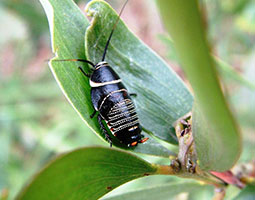Austral Ellipsidion
Description

Austral Ellipsidion, also known as the Beautiful Cockroach, is found in open forest Australia-wide. The adults are winged with bold, orange marks, however, the nymphs are easily identified with bands of fine, white spots across segments of their abdomen. They have long, spiny legs and antennae that are longer than their body. Their small head points downward concealed under the pronotum (plate-like structure that covers all or part of the thorax).
They grow to a length of 10-15mm, relatively smaller in size compared to other species. They forage on foliage of shrubs during the daytime but are never found inside houses. Females carry their eggs around in a hardened, protective case called an ‘ootheca’ attached to the abdomen, which is eventually deposited on the ground or buried in the soil.
Adaptations
- Bright colours advertise their distaste to predators
- Flat, broad body to squeeze into tight spaces
- Specialised sensors called ‘cerci’ (like rear-mounted antennae) that make them acutely aware of their surroundings, allowing them to scurry away quickly when disturbed
Feeding relationships
- What I eat: believed to feed on pollen, honeydew and mould fungus
- What eats me: birds, lizards, frogs, mammals and other invertebrates; they can also be parasitised by round worms and wasps
Interesting facts
The term ‘Beautiful Cockroach’ is considered an oxymoron, as the perception of these insects as beautiful is always outweighed by their name ‘cockroaches’.